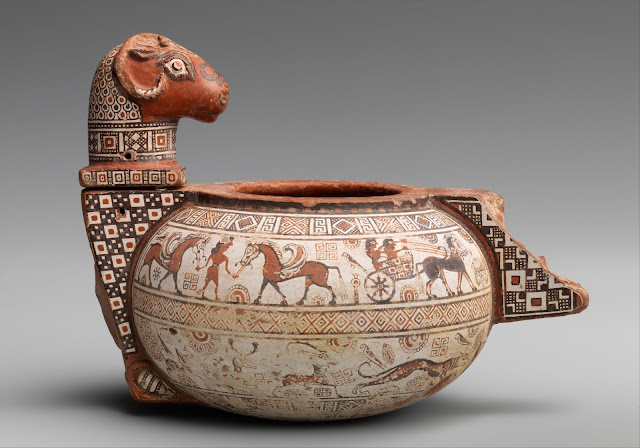Creative art at the birth of democracy
Terracotta cosmetic vase 4th quarter of the 6th century B.C.E. Archaic Period East Greek at the Metropolitan Museum of Art in New York
On one side of the upper frieze of this exquisite vase, a youth holds two winged horses and two youths drive a chariot. Real and imaginary animals circulate on the other frieze areas between carefully drawn geometric patterns. The ram's-head cover may have served as a handle for a cosmetic applicator.
In this period, there was huge economic development in Greece, and also in its overseas colonies which experienced a growth in commerce and manufacturing. There was a great improvement in the living standards of the population. Some studies estimate that the average size of the Greek household, in the period from 800 BC to 300 BCE, increased five times, which indicates a large increase in the average income of the population.
In the second half of the 6th century BCE, Athens fell under the tyranny of Peisistratos and then of his sons Hippias and Hipparchos. However, in 510 BC, at the instigation of the Athenian aristocrat Cleisthenes, the Spartan king Cleomenes I helped the Athenians overthrow the tyranny. Afterwards, Sparta and Athens promptly turned on each other, at which point Cleomenes I installed Isagoras as a pro-Spartan archon. Eager to prevent Athens from becoming a Spartan puppet, Cleisthenes responded by proposing to his fellow citizens that Athens undergo a revolution: that all citizens share in political power, regardless of status: that Athens become a "democracy". So enthusiastically did the Athenians take to this idea that, having overthrown Isagoras and implemented Cleisthenes's reforms, they were easily able to repel a Spartan-led three-pronged invasion aimed at restoring Isagoras. The advent of the democracy cured many of the ills of Athens and led to a 'golden age' for the Athenians.
Image: Terracotta cosmetic vase 4th quarter of the 6th century B.C.E. Archaic Period East Greek at the Metropolitan Museum of Art in New York.




Comments
Post a Comment